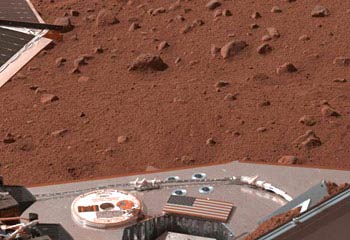Expensive Error: NASA’s Mars Probe Malfunctions
By Dan Whitcomb | Jun 10, 2008

NASA scientists are struggling to process the soil that the Phoenix Mars Lander scooped from the Red Planet’s surface, finding that the Martian dirt was too clumpy to sift into the spacecraft’s onboard laboratory.
The scientists called it an important day last week when the Phoenix’s robotic arm scraped its first, cup-sized sample from the planet’s surface, but since then have been unable to get any of the clotted soil through a screen into the lander’s Thermal Evolved Gas Analyser (TEGA).
“What we’ve found is although we had an awful lot of dirt on that screen virtually none of its has made it down into the oven,” said William Boynton of the University of Arizona in Tucson, who is overseeing the TEGA experiments.
The mission is searching for signs of water or conditions that could sustain life on Mars.
Pictures of the first sample dredged up by Phoenix showed it to be made up largely of dirt clods, which were too large to make it through the small holes in the screen.
Scientists spent the weekend vibrating the screen in hopes that the clods would break apart, but very few particles dropped into the instruments.
“We now at least know that the vibrator is functioning,” Mr Boynton said.
“It looks like the soil is just too adhesive to make it through when it’s put down as a mass.”
He said that if further attempts with TEGA’s vibrator failed to get a sufficient amount of dirt into the machine, the next step would be to try again with a second scoop of soil, this time sprinkling a small amount onto the screen in hopes that it would go through.
Mr Boynton said the team was optimistic that this dribbling technique would work and were not ready to give up on the soil samples.
“It would be at least a week or two before we would start to get terribly concerned,” he said. “We do have a fair number of things we’re going to be trying.”
The scientists don’t know why the Martian dirt has proved so clumpy, saying that the area under the lander could have gotten wet from the spacecraft’s thrusters or melting ice or that salts in the soil could act as a cementing agent.
The $420 million lander spent 10 months journeying from Earth and touched down on Mars 12 days ago. Its three-month mission was proposed after the Mars Odyssey detected frozen water below the Martian surface in 2002.
This is the lander’s first attempt to analyze soil, which might contain salt left behind by evaporated water or ice. They hope to learn what minerals make up the soil.












